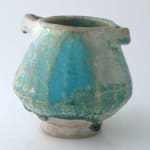Sassanian Glazed Cup, 200 CE - 600 CE
Terracotta
4.5 x 3.75
PF.2242
Further images
In 244 A.D., Ardeshir I founded the Sassanid Dynasty, the last native Persian Kingdom to rule Ancient Iran before the Islamic conquest. The Sassanid era was a golden age of...
In 244 A.D., Ardeshir I founded the Sassanid Dynasty, the last native Persian Kingdom to rule Ancient Iran before the Islamic conquest. The Sassanid era was a golden age of Persian culture that witnessed the revival of Zoroastrianism, an ancient mystical religion native to these lands, and a literary Renaissance spurred by the translation of many Old Persian epics recorded in cuneiform into the Middle Persian language of Pahlavi written in an alphabet derived from Aramaic. By introducing heightened international trade and commerce they created a legacy of political and economic diplomacy. They sponsored trade with the Romans (later on the Byzantines), their archenemy, to the west and the Chinese to the east. Excavations in China have unearthed gold and silver Sassanid coins covering a span of many centuries until the demise of the Empire during the reign of Khosrow II. However, the fall of the Empire had already started with a series of wars waged under the rule of Khosrow I, the father of Khosrow II. Challenged by the intensification of the same international commerce that had bore such wealth, struggles for national power and international prestige had escalated to an ungovernable degree. In the face of threats to his royal house, Khosrow II embarked upon military campaigns that would prove unsuccessful. By the close of his reign, the once mighty Sassanid Empire came to an end, paving the way for the rise of Islam in the Middle East.
This fascinating, glazed two-handled cup dates from the Sassanid period in the history of ancient Persian. During this period, the ceramic craftsmen of the region produced quality utilitarian vessels whose surface beauty was enhanced by thick, rich blue-green faience glazes. This glazing technique was inherited from the Parthian craftsmen who had in turn learned it from the ancient Egyptians. The interesting technical and qualitative traits of this glazing technique are beautifully demonstrated on this vessel. The faience glaze covers the interior surface of the cup as well as the majority of the exterior area. Toward the bottom of the cup, just above its ring base, the glaze ends in an uneven line around the perimeter of the vessel with a series of interspersed faience globules. This "free-flowing" element gives one the feeling that the artist has just this moment placed the hot glaze over the clay vessel. It is as if we can see the molten material slowly caress the sides of the cup, magically and artistically coming to a stop just before reaching the bottom. This unique glazed cup is made even more beautiful by the passage of time, adding a soft iridescence and an intricate pattern of tiny lines in the glaze. To own it today is to appreciate and enjoy the creativity of ancient craftsmanship.
This fascinating, glazed two-handled cup dates from the Sassanid period in the history of ancient Persian. During this period, the ceramic craftsmen of the region produced quality utilitarian vessels whose surface beauty was enhanced by thick, rich blue-green faience glazes. This glazing technique was inherited from the Parthian craftsmen who had in turn learned it from the ancient Egyptians. The interesting technical and qualitative traits of this glazing technique are beautifully demonstrated on this vessel. The faience glaze covers the interior surface of the cup as well as the majority of the exterior area. Toward the bottom of the cup, just above its ring base, the glaze ends in an uneven line around the perimeter of the vessel with a series of interspersed faience globules. This "free-flowing" element gives one the feeling that the artist has just this moment placed the hot glaze over the clay vessel. It is as if we can see the molten material slowly caress the sides of the cup, magically and artistically coming to a stop just before reaching the bottom. This unique glazed cup is made even more beautiful by the passage of time, adding a soft iridescence and an intricate pattern of tiny lines in the glaze. To own it today is to appreciate and enjoy the creativity of ancient craftsmanship.
Literature
V11











